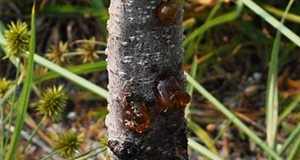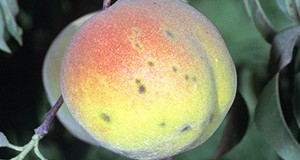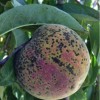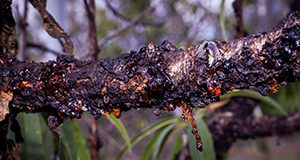Peach fungal gummosis (PFG) is a vascular disease that limits the growth and yield of peach orchards in the southeastern United States. This 6-page document discusses the symptoms and management of PFG. Written by Daniel Mancero-Castillo, Ali Sarkhosh, Sara Sherman, Mercy Olmstead, Philip Harmon, and Thomas Beckham and published by the UF/IFAS Horticultural Sciences Department, July 2018.
https://edis.ifas.ufl.edu/hs1265
Tag: Peach Plum and Nectarine Diseases
Fungal Gummosis in Peach

Fungal gummosis in peach occurs when the fungus Botryosphaeria dothidea infects small openings or wounds in tree branches or trunks. The disease causes blisters on the tree that form lesions and eventually ooze gum (sap). This 3-page fact sheet covers the disease cycle and management of fungal gummosis in peach, which is often difficult to control. Written by Sara Sherman, Mercy Olmstead, Philip Harmon, and Thomas Beckman, and published by the UF Department of Horticultural Sciences, July 2015.
http://edis.ifas.ufl.edu/hs1265
Peach Rust

Peach rust is a fungal disease that affect the leaves and, less commonly, twigs and fruit of peach trees. The fungus that causes peach rust thrives in Florida’s humid climate and may cause significant economic losses in severely affected orchards. This 5-page fact sheet details peach rust symptoms, disease cycle, and management, including fungicide treatments. Written by Courtney Ligon, Mercy Olmstead, and Phillip Harmon, and published by the UF Department of Horticultural Sciences, June 2015.
http://edis.ifas.ufl.edu/hs1263
Peach Scab
 Peach scab is a disease caused by the fungus Cladosporium carpophilum. The pathogen can infect other fruits and nuts within the Prunus species, like almonds, apricots, nectarines, and plums. Peach scab is common during periods of humid weather because rain splashes the conidia (asexual spores) from the fungus between leaves, twigs, and fruit in the tree canopy, which spreads the disease. This 6-page fact sheet was written by Daniel Mancero-Castillo, Mercy Olmstead, and Phillip Harmon, and published by the UF Department of Horticultural Sciences, July 2014.
Peach scab is a disease caused by the fungus Cladosporium carpophilum. The pathogen can infect other fruits and nuts within the Prunus species, like almonds, apricots, nectarines, and plums. Peach scab is common during periods of humid weather because rain splashes the conidia (asexual spores) from the fungus between leaves, twigs, and fruit in the tree canopy, which spreads the disease. This 6-page fact sheet was written by Daniel Mancero-Castillo, Mercy Olmstead, and Phillip Harmon, and published by the UF Department of Horticultural Sciences, July 2014.
http://edis.ifas.ufl.edu/hs1249
